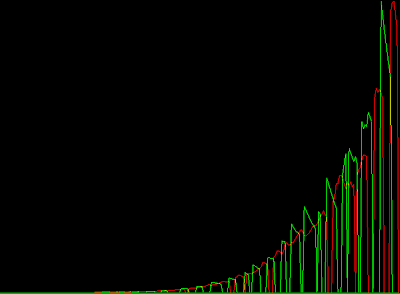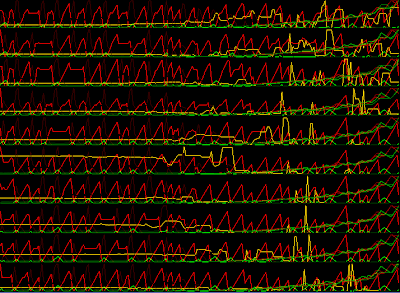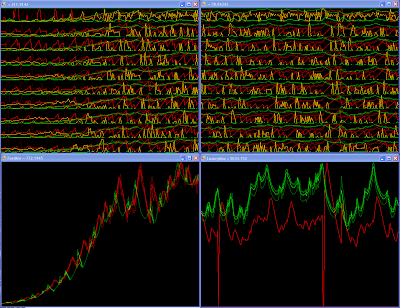Eve online is another interesting experiment in market simulation. Although they cheat and use actual humans as their agents. They need _alot_ of them. Last time I checked, they had reached a peak of 40k concurrent users. If that's what you need to run a stable economy, that makes and awful lot of blue collar workers. I don't know about you, but when I play video games, I don't quite enjoy being _lower_ on the totem pole than how I am in real life.
So, what if we could build a full economic simulation out of AI agents, make it a stable and growing economy of say, 1 million units or so, and _then_ throw in some 40k human players in the mix? Assuming that the human players are smarter/better at making money than the AI agents, then that gives everyone the opportunity to control on average 25 other agents. Now _everyone_ can be the boss!
Back to reality. Who would have guessed that Adam Smith and Milton Friedman would be useful for game development. I tried to extract from their books the essence of a free market economy. It seems that the free market sounds alot like a multi-agent simulation.
We will setup the agent "Collective" as a graph. Each agent has a list of n neighbors, or friends, and only does business with them. This allows us to scale the simulation to 1 million without having to manage too many possible iterations. It also can help simulate the effect of "distance" and also trusted business partners. Everyone has their favorite place to shop, and producers have their favorite distributors. We can also bestow upon some lucky agents the ability to have more friends, making them "hubs" in the network. This would therefore give rise to market makers, distributors and merchants.
We'll make it a seller's market. The burden of setting the right sale price is on the producers. Producers put their goods on the market an arbitrary price. If it sells out, next round he will raise his price. If he is left with stock, next round he will lower his price.
The buyers will try to find the cheapest sale price for the good they wish to buy. They can only buy from their friends, so the search is bounded to a small set. Furthermore, we will incrementally sort the friend list by price, making this decision quite simple and quick.
Different agents will have different abilities. Each agent has a set of "business plans" available to execute. These business plans consist of "Actions". Actions are composed of a given "Technology", that operates on an instance of an "Asset". The Asset must provide the given type of "Capital" required by the Technology.
A given type of technology will have inputs (eg: labor), and outputs (eg: food, luxury goods). The technology specifies how many units of the inputs are required to produce a number of outputs. This way, different technologies can achieve similar goals, but with different efficiencies. As an example, consider farming. You can have BasicFarming that consumes 1 unit of labor, producing 1 unit of food, versus IrrigatedFarming, consuming 1 unit of water, 1 unit of labor, producing 1.5 units of food.
Capital is a property of an Asset, determining what one can do with that asset. For example, plains are suitable for growing food, and for raising livestock. Mountains would be suitable for Mining. Hills might be suitable for both, albeit at a lesser capacity. The idea here is to be able to simulate ownership of land, and investment in capital. You could buy an asset, containing unimproved forest. You could then cut down the trees (and sell the wood), leaving you with plains. You can now do farming on your plot of land. You could improve plains by doing irrigation works, increasing farming yields. You can improve a plot of land by building a factory, therefore making it now suitable for manufacturing.
We can't do everything at once, so let's get down to what I've done, and see how that goes.
In the simulation runs that we will soon see, There are two Technologies known by society. One is to produce food, the other is to produce art. Call it bread and games;) Producing food requires farmland, and producing art requires some sort of studio, park, or any other inspiring place.
For now, there exists only one Asset that we call "The Commons". Everyone can use it, and it allows everyone to produce food, and make art.
Simulation run 1: 10 agents, symmetric abilities.

Price of goods as a function of time. Red: Food. Green: Luxury Goods (art)

Stats per agent. Yellow bar: money. Bright Red/Green: Food/Art Quantity in stock. Dark Red/Green: Ask price.
What we're trying to get out of this simulation is self adjusting prices. We want the market to work. We expect the prices of various goods to stabilize according to supply and demand.
In this case, the market failed. Everyone can produce both Art and Food, so trading is not really necessary. The market can't quite find an equilibrium.
Simulation run 2: 10 agents, 1 luxury good expert, 9 food producers.


In simulation run 2, we have setup one agent that knows only how to make art, and the other 9 can make only food. We simulate division of labour.
Prices are stable, but they eventually converge towards zero. What seems to be happening here is that with 9 agents producing food, they compete with each other to sell food to the other agent. Prices free fall. The food agents can do nothing else but produce food, so they do so merrily. We have not yet introduced any required inputs to producing food aside from labor. Since we haven't programmed a minimum wage, and the agents do not know laziness, the low price of food is unbounded.
The artist gets rich. No two ways about that. The price of art increases, until all the agents have spent all their money. Without any money to buy the art, trading ceases, and the artist stockpiles his art, therefore he starts lowering his price.
This is obviously still not what we are looking for.
Simulation run 3: Asymmetric agents, Artist can only make food poorly, but is good at art. Farmers are good at food, but only adequate artists.

The panes on the left show the "bootup" state. The panes on the right show a snapshot of some frame later in the simulation. (click on the image to enlarge)
It seems we've finally found a stable system. The trading graph looks suspiciously like a stock market ticker ;) The vertical axis is always rescaled for maximum range, so it is not possible to tell on these pictures, but the price of Art is stable at roughly 9x the price of food. This is what we expected, with 9x the labor force specialized in food.
Soon we will tackle real estate purchase and capital investment. Stay tuned.
2 comments:
Hi! This is 'frikk' from reddit.
Awesome experiment. How far have you come on your other trials? How long have you run the trials for (minutes, hours)? Have you tried a genetic algorithm that varies the amount of art vs food that an agent can produce, perhaps driving the system into other alternative stable states?
-Blaine
I think the longest I've run the simulation is around 10000 turns. Once it reaches a steady state, it pretty much stays there. The simulation is stable enough that there was no point continuing longer.
I havn't tried to use a genetic algorithm as mentioned. With only 2 goods to produce, I doubt that the exercise would produce much. Once the simulation gets more complicated, that would be worth trying. Although here we would be talking serious amounts of computation time.
Interesting tidbit: My current engine uses a genetic algorithm in a very interesting way. I'll have to post about it now that you're asking... stay tuned.
Post a Comment